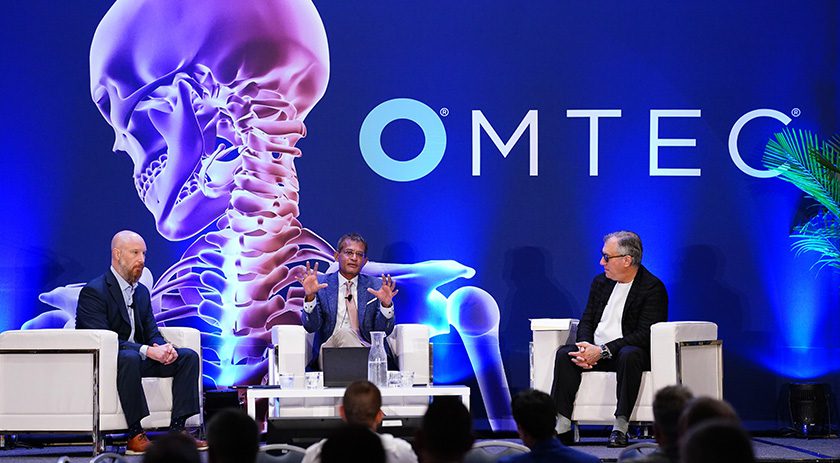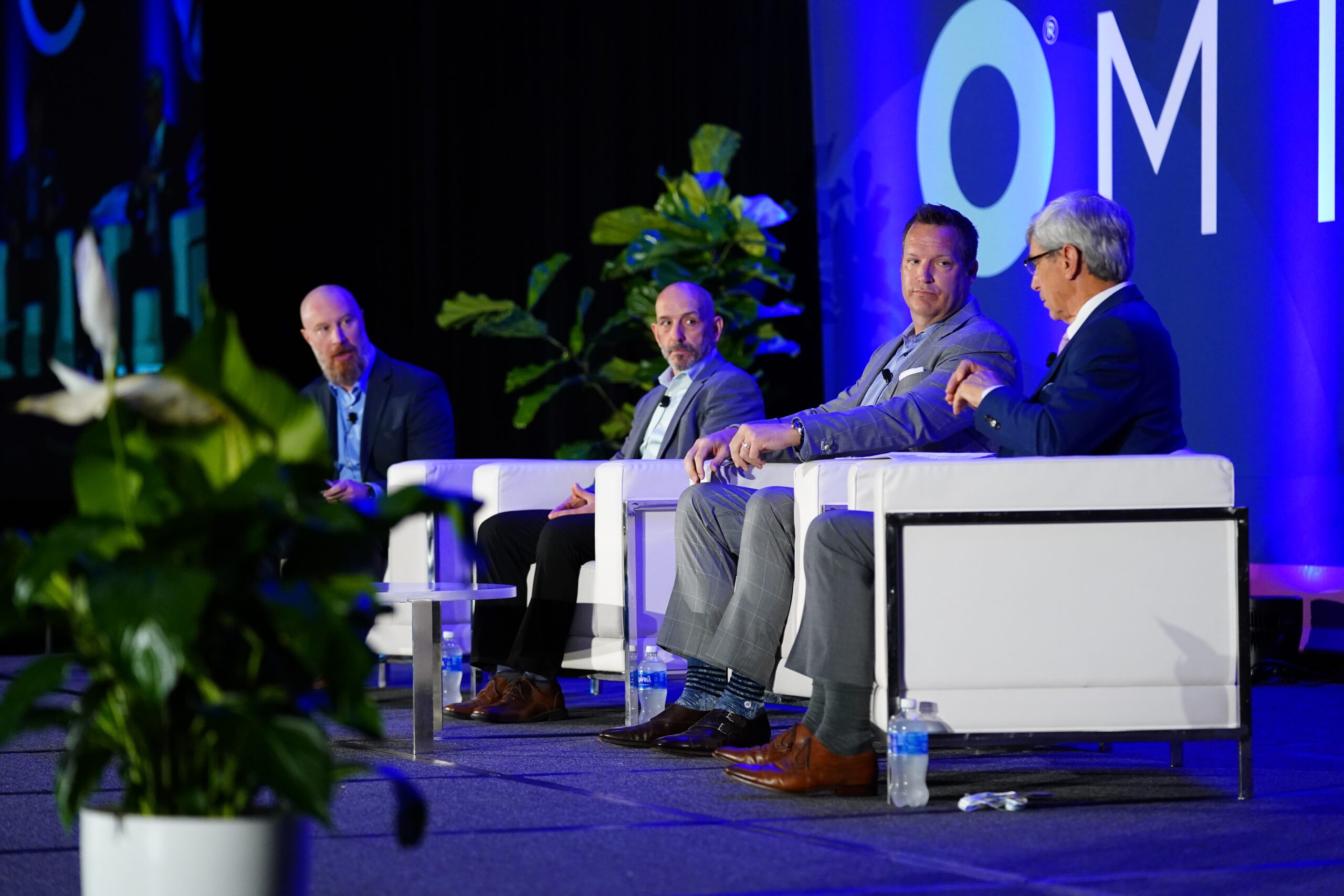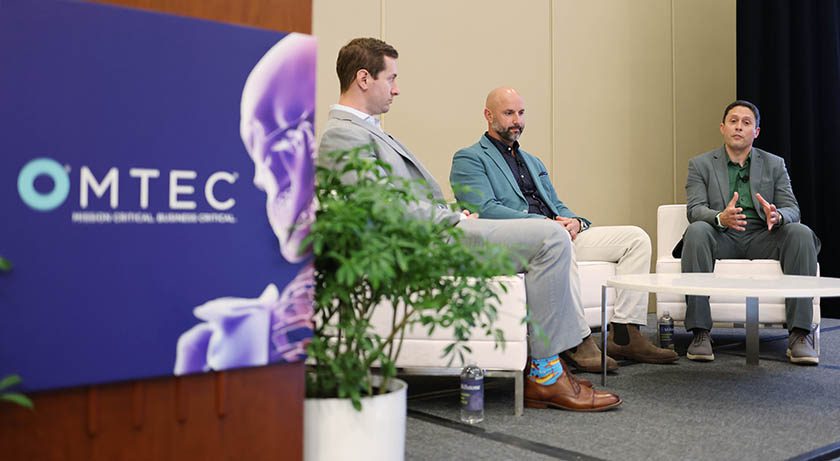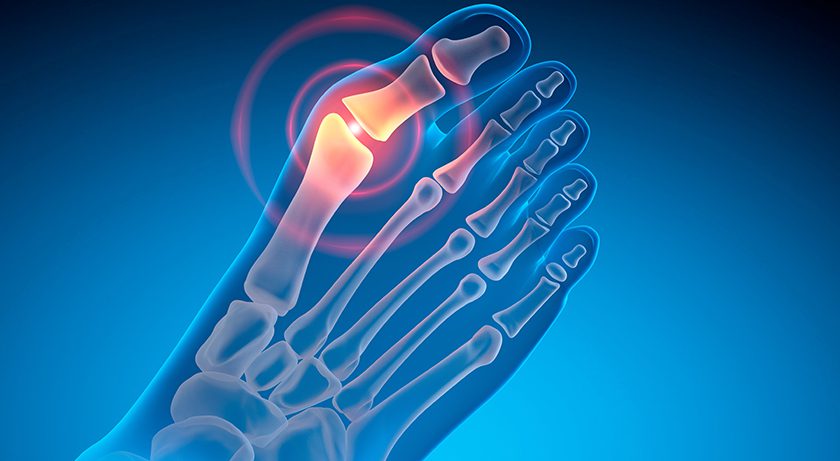

 Copy to clipboard
Copy to clipboard 
Once again, I had the honor of moderating the keynote panel for OMTEC 2024. This year, we looked forward to the challenges and opportunities for the orthopedic market with two surgeon entrepreneurs:
- Ira Kirschenbaum, M.D., Chair of Orthopaedic Surgery, BronxCare Health System
- Sharat Kusuma, M.D., President, JointMedica
Dr. Ira Kirschenbaum is the Chair of Orthopedic Surgery at the BronxCare Health System, one of the largest non-profit, non-governmental safety-net health systems. It services the 15th Congressional District in New York, the poorest congressional district in the nation. Dr. Kirschenbaum continues to have a notable and unique career as an orthopedic surgeon with in-depth and wide-breadth entrepreneurial, corporate and healthcare leadership experience
Dr. Sharat Kusuma is a physician executive who brings a unique combination of business, finance and clinical experience to his roles. Since 2019, he has served as the Chief Strategy Officer, Senior Vice President of Business Development and Chief Medical Officer at Exactech. Most recently, he was appointed President of JointMedica. He has also worked at Apple and McKinsey.
Given the diverse experience of our speakers, our conversation covered a range of topics, from the payor and health system dynamic to the look-and-feel of robotics. Below, we dive into three major themes that emerged during the talk: the broken value equation, the blurring of industry lines through consolidation and pain points addressed by technology.
You Can’t Cost-Cut Yourself to Prosperity
I opened our discussion by asking Dr. Kirschenbaum how the evolving orthopedic industry might impact the value equation, which holds that value equals outcomes over cost.
“It’s a trick question,” he said. “I don’t think the value equation ever worked in orthopedics. The big failure in the value equation is there is no revenue.”
Dr. Kirschenbaum said the development of BronxCare Health System, which serves 1.15 million people, hinged on a balanced model that accounts for outcomes, cost and revenue. He said creative compensation packages for surgeons are crucial because they are the sole revenue generators in the equation.
“We have a revenue crisis in healthcare, not a cost crisis,” said Dr. Kirschenbaum. “You cannot cost-cut yourself to prosperity.”
Dr. Kusuma agreed and offered himself as an example of the broken value equation as he left clinical practice to join the industry. He thinks the revenue dynamics for surgeons are driving them out of academic medical centers and to the ASC model.
“I trained at Rush here in Chicago,” he said. “Many prolific hip and knee surgeons are my colleagues and contemporaries. These folks who worked at prestigious academic medical centers have left those posts. They’re all migrating to an environment that allows them to have that revenue piece. The market is showing the value equation is broken.”
Dr. Kirschenbaum said the ASC model offers orthopedic surgeons passive income ranging from tens to hundreds of thousands of dollars.
“If anyone tells you that’s not what is driving ASC care, they’re crazy,” he said.
Consolidation Blurring Industry Lines
Dr. Kirschenbaum believes there is a bit of an identity crisis between payers and healthcare systems as consolidation changes a company’s foundational culture. He said he wouldn’t be surprised if Northwell Health, New York’s largest healthcare provider, bought a health insurance provider to become a for-profit Kaiser Permanente.
Dr. Kusuma provided two examples of health systems with their own insurance products: Intermountain Health and the University of Pittsburgh Medical Center.
“The reason health systems are getting into the insurance business is because they see how profitable it is,” he said. “Heath systems want a piece of that pie. They can regulate how much is spent in the population they cover.”
However, payors and health systems aren’t the only ones blurring the lines. As technology adoption increases in orthopedics and data becomes more valuable, device companies are moving toward service-provider roles.
According to Dr. Kirschenbaum, the words service and pain are linked for companies. He cautioned service providers to invest time and energy in truly understanding the customer’s needs. “You cannot be a service provider if you’re not solving their pain points,” he said.
Dr. Kusuma sees margins as another tricky issue for service providers. By far, orthopedics’ biggest margins are in selling metal and plastic, where nearly all of the intellectual energy goes.
“It’s hard to unlock a margin in being a service provider,” he said. “Even doctors don’t get paid very much for seeing a patient. How is there anything left for a service provision? As things evolve with technology and the ASC, maybe there’s an opportunity to have a profitable business unit. Those are some existential questions I think about for the service provision.”
Technology’s Promise and Needed Caution
Both speakers acknowledged the outsized marketing cache orthopedic enabling technology enjoys, especially within the robotics space. Dr. Kusuma cited a poll in which nearly half of the surgeon respondents said marketing and peer pressure influenced their decision to use technology.
Beyond the hype, however, the emerging ecosystem of technology in the industry can have wide-ranging benefits for all stakeholders.
Dr. Kusuma was astounded that in 2024, a knee replacement patient still has to physically return to the surgeon’s office in six weeks, calling it “the most caveman thing.” While having a waiting room full of patients may be efficient for the surgeon, it isn’t the best thing for anyone involved. He said the industry could do much better to reduce the management burden through technology like wearables.
Close to 2 million joint replacement surgeries are performed in the U.S. annually. According to Dr. Kusuma, self-identified non-specialist orthopedic surgeons perform around 75% of primary knee surgeries. Technology has a massive opportunity to improve surgical outcomes among that group.
“Some of the big orthopedic conferences have these sessions we call the disaster-plasty where everyone tries to put up the worst case possible,” he said. “Like, the acetabular cup is in the pelvis. Why do these happen, generally? The primary surgery wasn’t right. There’s a massive opportunity to help the average surgeon who does 20 to 30 joints a year to improve. You’d be crazy to drive without a Waze app or something. We’re undersaturated with accessible technology for every surgeon.”
Dr. Kirschenbaum cautioned against healthcare technology serving only the wealthy. A significant portion of his population has no insurance or “crummy” insurance, and only 6% have access to the Internet.
“When I came to BronxCare, they did 25 joint replacements. Now we do 1200 and pay with American dollars. That’s real money and real change. We must be careful that the digital episode of care is not only helping certain people. There’s a whole world out there,” he said.
Once again, I had the honor of moderating the keynote panel for OMTEC 2024. This year, we looked forward to the challenges and opportunities for the orthopedic market with two surgeon entrepreneurs:
Ira Kirschenbaum, M.D., Chair of Orthopaedic Surgery, BronxCare Health System
Sharat Kusuma, M.D., President, JointMedica
...
Once again, I had the honor of moderating the keynote panel for OMTEC 2024. This year, we looked forward to the challenges and opportunities for the orthopedic market with two surgeon entrepreneurs:
- Ira Kirschenbaum, M.D., Chair of Orthopaedic Surgery, BronxCare Health System
- Sharat Kusuma, M.D., President, JointMedica
Dr. Ira Kirschenbaum is the Chair of Orthopedic Surgery at the BronxCare Health System, one of the largest non-profit, non-governmental safety-net health systems. It services the 15th Congressional District in New York, the poorest congressional district in the nation. Dr. Kirschenbaum continues to have a notable and unique career as an orthopedic surgeon with in-depth and wide-breadth entrepreneurial, corporate and healthcare leadership experience
Dr. Sharat Kusuma is a physician executive who brings a unique combination of business, finance and clinical experience to his roles. Since 2019, he has served as the Chief Strategy Officer, Senior Vice President of Business Development and Chief Medical Officer at Exactech. Most recently, he was appointed President of JointMedica. He has also worked at Apple and McKinsey.
Given the diverse experience of our speakers, our conversation covered a range of topics, from the payor and health system dynamic to the look-and-feel of robotics. Below, we dive into three major themes that emerged during the talk: the broken value equation, the blurring of industry lines through consolidation and pain points addressed by technology.
You Can’t Cost-Cut Yourself to Prosperity
I opened our discussion by asking Dr. Kirschenbaum how the evolving orthopedic industry might impact the value equation, which holds that value equals outcomes over cost.
“It’s a trick question,” he said. “I don’t think the value equation ever worked in orthopedics. The big failure in the value equation is there is no revenue.”
Dr. Kirschenbaum said the development of BronxCare Health System, which serves 1.15 million people, hinged on a balanced model that accounts for outcomes, cost and revenue. He said creative compensation packages for surgeons are crucial because they are the sole revenue generators in the equation.
“We have a revenue crisis in healthcare, not a cost crisis,” said Dr. Kirschenbaum. “You cannot cost-cut yourself to prosperity.”
Dr. Kusuma agreed and offered himself as an example of the broken value equation as he left clinical practice to join the industry. He thinks the revenue dynamics for surgeons are driving them out of academic medical centers and to the ASC model.
“I trained at Rush here in Chicago,” he said. “Many prolific hip and knee surgeons are my colleagues and contemporaries. These folks who worked at prestigious academic medical centers have left those posts. They’re all migrating to an environment that allows them to have that revenue piece. The market is showing the value equation is broken.”
Dr. Kirschenbaum said the ASC model offers orthopedic surgeons passive income ranging from tens to hundreds of thousands of dollars.
“If anyone tells you that’s not what is driving ASC care, they’re crazy,” he said.
Consolidation Blurring Industry Lines
Dr. Kirschenbaum believes there is a bit of an identity crisis between payers and healthcare systems as consolidation changes a company’s foundational culture. He said he wouldn’t be surprised if Northwell Health, New York’s largest healthcare provider, bought a health insurance provider to become a for-profit Kaiser Permanente.
Dr. Kusuma provided two examples of health systems with their own insurance products: Intermountain Health and the University of Pittsburgh Medical Center.
“The reason health systems are getting into the insurance business is because they see how profitable it is,” he said. “Heath systems want a piece of that pie. They can regulate how much is spent in the population they cover.”
However, payors and health systems aren’t the only ones blurring the lines. As technology adoption increases in orthopedics and data becomes more valuable, device companies are moving toward service-provider roles.
According to Dr. Kirschenbaum, the words service and pain are linked for companies. He cautioned service providers to invest time and energy in truly understanding the customer’s needs. “You cannot be a service provider if you’re not solving their pain points,” he said.
Dr. Kusuma sees margins as another tricky issue for service providers. By far, orthopedics’ biggest margins are in selling metal and plastic, where nearly all of the intellectual energy goes.
“It’s hard to unlock a margin in being a service provider,” he said. “Even doctors don’t get paid very much for seeing a patient. How is there anything left for a service provision? As things evolve with technology and the ASC, maybe there’s an opportunity to have a profitable business unit. Those are some existential questions I think about for the service provision.”
Technology’s Promise and Needed Caution
Both speakers acknowledged the outsized marketing cache orthopedic enabling technology enjoys, especially within the robotics space. Dr. Kusuma cited a poll in which nearly half of the surgeon respondents said marketing and peer pressure influenced their decision to use technology.
Beyond the hype, however, the emerging ecosystem of technology in the industry can have wide-ranging benefits for all stakeholders.
Dr. Kusuma was astounded that in 2024, a knee replacement patient still has to physically return to the surgeon’s office in six weeks, calling it “the most caveman thing.” While having a waiting room full of patients may be efficient for the surgeon, it isn’t the best thing for anyone involved. He said the industry could do much better to reduce the management burden through technology like wearables.
Close to 2 million joint replacement surgeries are performed in the U.S. annually. According to Dr. Kusuma, self-identified non-specialist orthopedic surgeons perform around 75% of primary knee surgeries. Technology has a massive opportunity to improve surgical outcomes among that group.
“Some of the big orthopedic conferences have these sessions we call the disaster-plasty where everyone tries to put up the worst case possible,” he said. “Like, the acetabular cup is in the pelvis. Why do these happen, generally? The primary surgery wasn’t right. There’s a massive opportunity to help the average surgeon who does 20 to 30 joints a year to improve. You’d be crazy to drive without a Waze app or something. We’re undersaturated with accessible technology for every surgeon.”
Dr. Kirschenbaum cautioned against healthcare technology serving only the wealthy. A significant portion of his population has no insurance or “crummy” insurance, and only 6% have access to the Internet.
“When I came to BronxCare, they did 25 joint replacements. Now we do 1200 and pay with American dollars. That’s real money and real change. We must be careful that the digital episode of care is not only helping certain people. There’s a whole world out there,” he said.

You are out of free articles for this month
Subscribe as a Guest for $0 and unlock a total of 5 articles per month.
You are out of five articles for this month
Subscribe as an Executive Member for access to unlimited articles, THE ORTHOPAEDIC INDUSTRY ANNUAL REPORT and more.
ME
Mike Evers is a Senior Market Analyst and writer with over 15 years of experience in the medical industry, spanning cardiac rhythm management, ER coding and billing, and orthopedics. He joined ORTHOWORLD in 2018, where he provides market analysis and editorial coverage.







